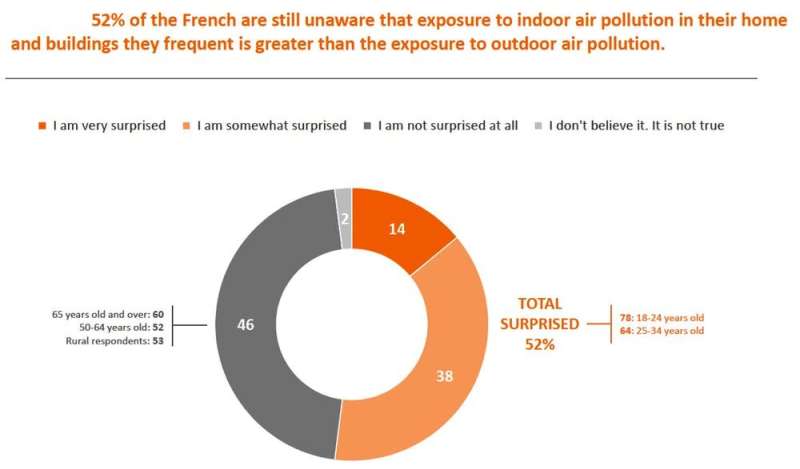From Paris to Shanghai, people are largely unaware of indoor air pollution risks

Outdoor air pollution has been widely studied and regulated for decades, but the quality of indoor air and its potential risks were little unrecognised until the early 2000s. Yet in temperate climates we can spend up to 90% of our time in closed environments (houses, schools, offices, transportation, etc.), where we may be exposed to numerous pollutants. The question of indoor air quality has therefore become a major public health concern across the globe.
Outdoor and indoor air is considered polluted when a chemical, physical or biological agent changes the natural characteristics of the atmosphere. Particulate matter, carbon monoxide, ozone, nitrogen dioxide and sulphur dioxide are some of the most hazardous pollutants. Apart from pollutants entering from outdoor air, the potential sources of pollution inside buildings are manifold: fuel-burning appliances, construction materials, housekeeping products, paint, tobacco, dust mites and more.
High health and socioeconomic costs
Air pollution is one of the main environmental risks worldwide and the fourth biggest risk factor for mortality globally. It not only provokes respiratory and cardiovascular diseases, cancer, allergies and asthma, but is also indirectly linked to productivity loss (affecting comfort, workplace well-being, etc.).
Indoor air can far more polluted than outdoor air and was responsible for 3.8 million premature deaths worldwide in 2016. According to evaluations in France, indoor air quality is poor in 60% of homes, and 34% of tertiary premises—that is, one out of two offices, and three out of five classrooms—that are not equipped with an air ventilation or treatment systems. This has significant consequences for society, which must shoulder a cost of around 19 billion euros linked to premature deaths, health care expenses, productivity loss, etc. Children are among the most vulnerable, taking around 40 breaths per minute on average (as opposed to 16 in adults), meaning the quality of air in closed spaces for young people is a priority.
A study conducted by Elabe for Veolia Group on air pollution was published on World Environment Day, June 5. It surveyed thousands of citizens in France, Belgium, and Shanghai. The idea was to evaluate the general public's level of awareness on the issue of indoor air pollution. Here is a look at the main lessons from the survey.

The study points to the general public's growing awareness
While 90% of French people believe that their health is affected by the quality of air they breathe at home, in transportation and in public buildings, most do not properly evaluate the health risks and underestimate the level of indoor air pollution, in particular in private spaces. Some 52% are surprised (including 14% very surprised) to learn that we are more exposed to pollution from the air inside our houses and other buildings than we are from the air outdoors. Three out of four incorrectly think that the air quality in their homes is good. There is a prevailing impression of a lack of information concerning prevention, indoor air quality measurements, solutions and health implications: less than one in two French people believe they have enough information about what needs to be done. Regarding measurement and treatment, 67% say they are ill-informed about the available systems, and nearly two in five are simply unaware of the existence of measuring sensors and ventilation and filtration systems that operate when indoor air quality is unhealthy.
These results are fairly similar to those in Belgium, where 60% of respondents were surprised (including 16% "very surprised") to learn that exposure to indoor air pollution is a greatest risk than outdoor pollution. Three out of four believed that the air inside their homes was of good quality, significantly more than for outdoor air. One in two respondents considered air quality to be bad nationwide, and one in three thought the air quality was bad in their town or neighbourhood (in France, two out of five thought air quality was bad nationwide, and three out of ten thought it was bad in their town).
In Shanghai, most residents saw a link between their health and the quality of the air they breathe, both outside and within their houses and other buildings. Some 95% thought their health is affected by the quality of air they breathe at home, in transportation and in public buildings. However, awareness of the issue does not always translate to being well informed. While the majority of respondents said they are aware of preventative measures (76%), of the quality of the air in the places they visit (55%) and of available means for improving it (64%), most did not properly evaluate the health risks, and underestimated the level of indoor air pollution, in both private and public spaces.
How can we improve the situation?
The World Health Organisation (WHO) estimates the cost of air pollution could rise to over 1% of global GDP by 2060. The vast majority of respondents in the countries covered by the study consider that the quality of indoor air is a health challenge requiring efforts—regulation, information and solutions—from all involved.
In France, the Health and Environment ministries launched a plan of action on indoor air quality in 2013. Among other important steps, it included monitoring the air quality in some public establishments, including schools and childcare centres. As of January 1, 2018, air-quality monitoring is compulsory in childcare centres, kindergartens and primary schools. The measure will apply to all similar establishments from January 1, 2023.
While all stakeholders, both private and public, at every level (down to the most local) have a role to play in the improvement of indoor air quality, 45% of French respondents believed that the government has a "very important" role to play and 85%, felt regulation is an "important" or "very important" mechanism for change.
Provided by The Conversation
This article is republished from The Conversation under a Creative Commons license. Read the original article.![]()

















